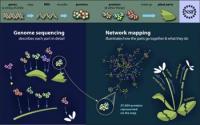
Proteins are essential components of Arabidopsis parts, such as petals, stalks and flowers. The genetics of these essential proteins were previously identified through studies involving genome sequencing. An international consortium of scientists has produced the first systematic network map of interactions that occur between proteins in the plant Arabidopsis thaliana. (Arabidopsis is a mustard plant that has 27,000 proteins and serves as a popular model organism for biological studies of plants, analogous to lab rats that serve as popular model organisms for biological studies of animals.)
Known as an "interactome," the new Arabidopsis network map defines 6,205 protein-to-protein Arabidopsis interactions involving 2,774 individual proteins. By itself, this map doubles the volume of data on protein interactions in plants that is currently available.
The new network map is covered in the July 29th issue of Science. It was produced with partial funding from the National Science Foundation by the so-called "Arabidopsis Interactome Mapping Consortium." The Consortium has an international membership and is composed of many institutions and researchers.
The Consortium's new network map of Arabidopsis has already provided the foundation for new discoveries involving plant growth and disease resistance. For example, the July 29 issue of Science features a companion study that--built on the new map-- identifies proteins that help Arabidopsis fight various pathogens. Such findings may help advance efforts to improve crop plants.
The production of the Arabidopsis network map was made possible, in part, by the previous production of the genome sequence of Arabidopsis; this sequence is a veritable "parts list" of the plant's genetic components. But more revealing than the genome sequence, the network map provides insights on the functions of proteins, the compositions of protein communities, and the evolutionary changes of proteins through time, among other things. (See illustration.)
"This starts to give us a big, systems-level picture of how Arabidopsis works, and much of that systems-level picture is going to be relevant to--and guide further research on--other plant species, including those used in human agriculture and even pharmaceuticals," says Salk Institute biologist Joseph Ecker, a senior member of the Consortium.
Nevertheless, because of the vast complexity of Arabidopsis's biology, the 6,205 Arabidopsis protein-to-protein interactions identified in the plant's new network map represents only about two percent of Arabidopsis protein interactions. Larger and more sensitive maps that identify more of these interactions are expected to be developed in the future.
Source : National Science Foundation
 Print Article
Print Article Mail to a Friend
Mail to a Friend
